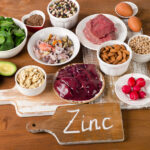Key Facts
- Zinc is important for your immune system.
- Your body can’t make zinc so you need to get it through your diet.
- Teenage girls need about 8-9mg of zinc every day.

Zinc is a mineral that is important for your immune system. Zinc is also needed for wound healing, normal growth, and development.
How much zinc do I need?
Because your body cannot make zinc, you must get it through your diet. The amount of zinc you need daily, or the recommended dietary allowance (RDA), depends on your age and gender. Girls ages 9 to 13 years old need 8 milligrams of zinc each day. Girls ages 14 to 18 years old need 9 milligrams each day.
How do I know if I’m getting enough zinc?
Most people who eat a balanced diet get enough zinc daily. Because a large variety of foods contain zinc (see list below), getting enough shouldn’t be an issue for a healthy young adult. Some people who may be at risk for zinc deficiency include those with inflammatory bowel diseases such as Crohn’s or colitis, those who have recently undergone bariatric surgery, people who are pregnant or lactating, and those who follow vegan diets. If you think you may be at risk for zinc deficiency, speak to your PCP or a dietitian.
Can I get too much zinc?
It is extremely rare to get too much zinc from the diet. However, taking a supplement when a provider hasn’t prescribed it to you can be risky. Since zinc is important for the immune system, some people believe that taking zinc supplements when they have a cold may be beneficial. The research on this in inconclusive, meaning that there is no evidence to say this works. Excessive intake of zinc supplements can affect the absorption of other necessary minerals like copper and magnesium, affect cholesterol levels, and reduce immune function.
What are some good sources of zinc?
There are many different foods that contain zinc. Oysters contain the highest amount of zinc, but red meat and poultry are the most commonly eaten sources of zinc. Other foods that contain zinc include:
- Dairy products
- Fortified breakfast cereals
- Legumes
- Meat, poultry, and shellfish
- Soy foods
- Whole grains
| Food | Serving | Milligrams (mg) of zinc per serving |
| Dairy Foods | ||
| Yogurt, plain, low-fat | 1 cup | 1.78 |
| Ricotta cheese, part skim | 1/2 cup | 1.34 |
| 1% milk | 1 cup | 0.86 |
| Cheddar cheese | 1 ounce | 1.0 |
| Grains and Cereals | ||
| Brown rice, cooked, long grain | 1/2 cup | 0.7 |
| Cheerios® cereal | 1/2 cup | 13.4 |
| Life® cereal | 1/2 cup | 5.8 |
| Wheat germ | 1 Tbsp | 2.4 |
| Legumes | ||
| Chickpeas | 1/2 cup | 1.4 |
| Lentils | 1/2 cup | 1.2 |
| Lima beans | 1/2 cup | 0.9 |
| Meat, Poultry, Shellfish, and Eggs | ||
| Chicken breast | 3 ounces | 0.8 |
| Egg, large | 1 egg | 1.2 |
| Hamburger, 95% lean | 3 ounces | 3.1 |
| Shrimp | 6 large | 1.6 |
| Sirloin steak | 3 ounces | 5.7 |
| Turkey | 3 ounces | 2.8 |
| Oysters | 3 oysters | 66 |
| Soy Foods | ||
| Soybeans | 1/2 cup | 1.1 |
| Tempeh | 1/2 cup | 1.1 |
| Tofu, firm | 1/2 cup | 1.6 |
Our health guides are developed through a systematic, rigorous process to ensure accuracy, reliability, and trustworthiness. Written and reviewed by experienced healthcare clinicians from Boston Children's Hospital, a Harvard Medical School teaching hospital and consistently ranked as a top hospital by Newsweek and U.S. News & World Report, these guides combine clinical expertise, specialized knowledge, and evidence-based medicine. We also incorporate research and best practices from authoritative sources such as the CDC, NIH, PubMed, top medical journals, and UpToDate.com. Clinical specialists and subject matter experts review and edit each guide, reinforcing our commitment to high-quality, factual, scientifically accurate health information for young people.

